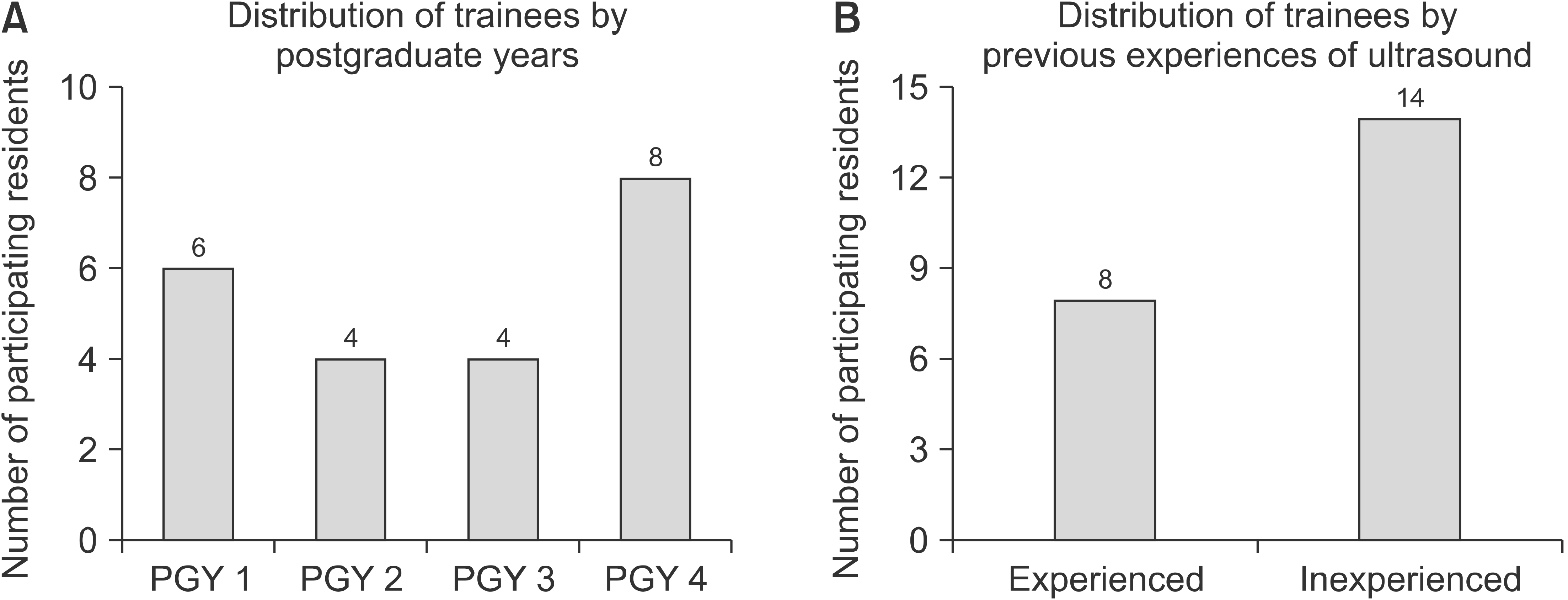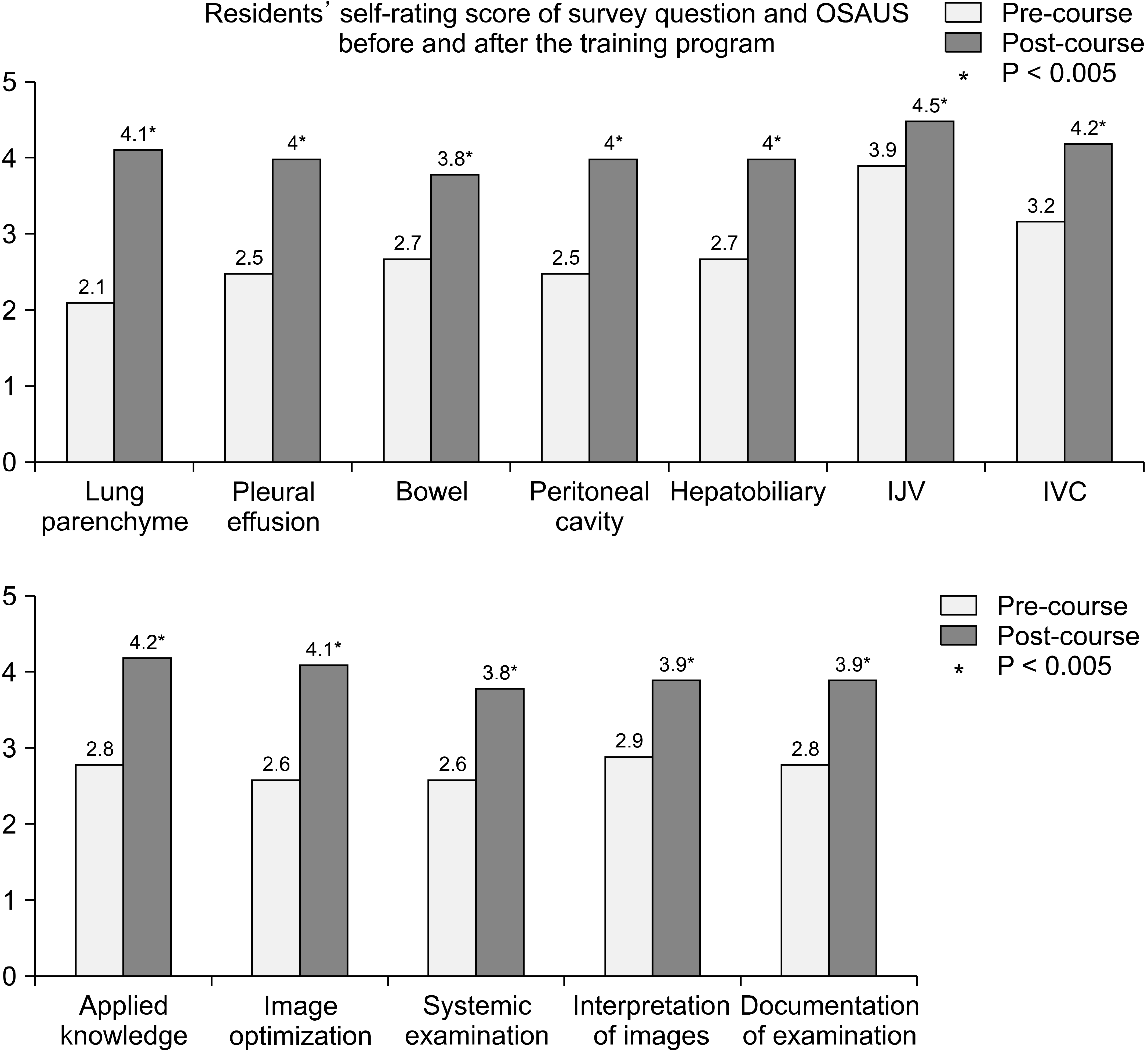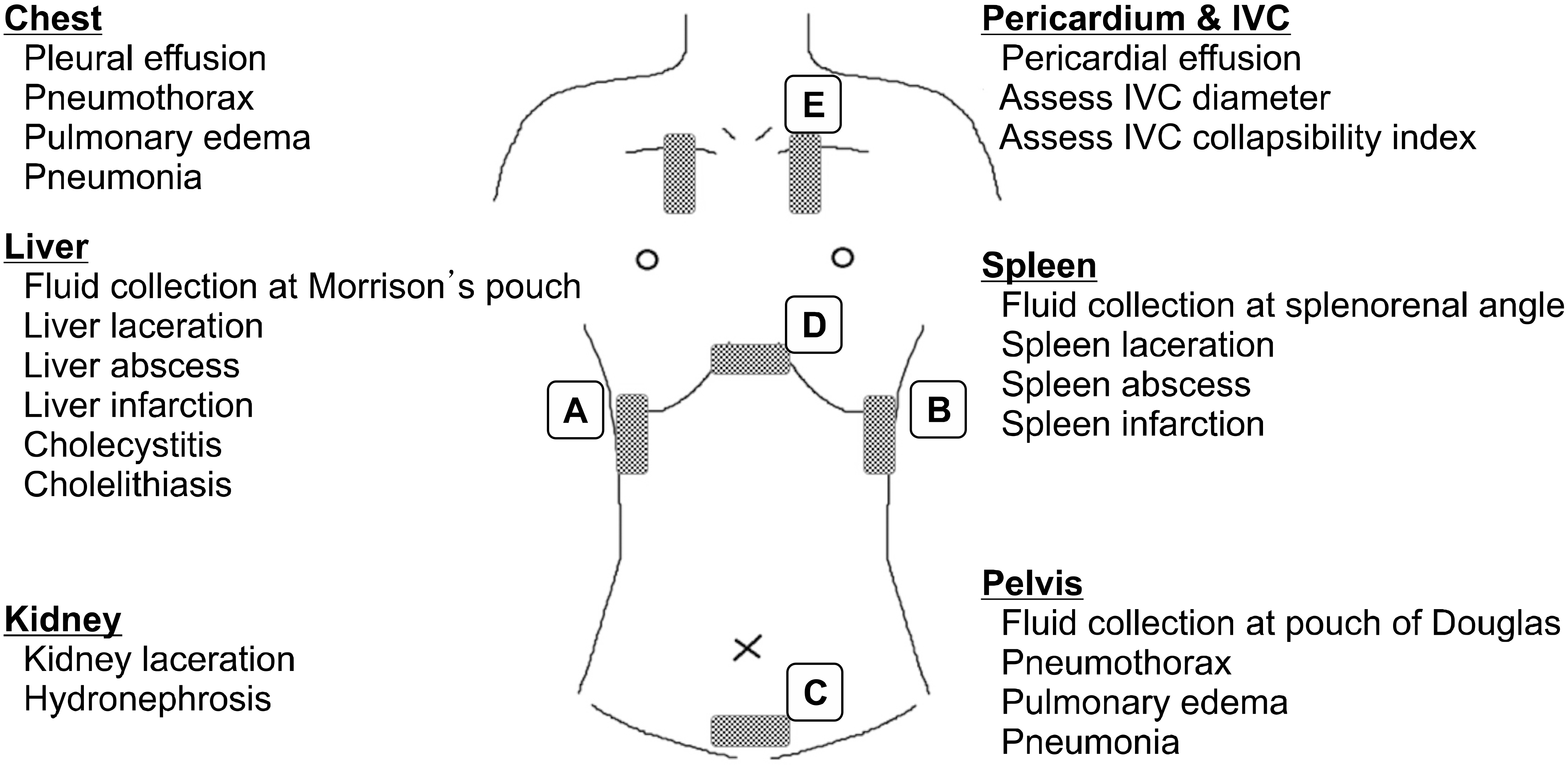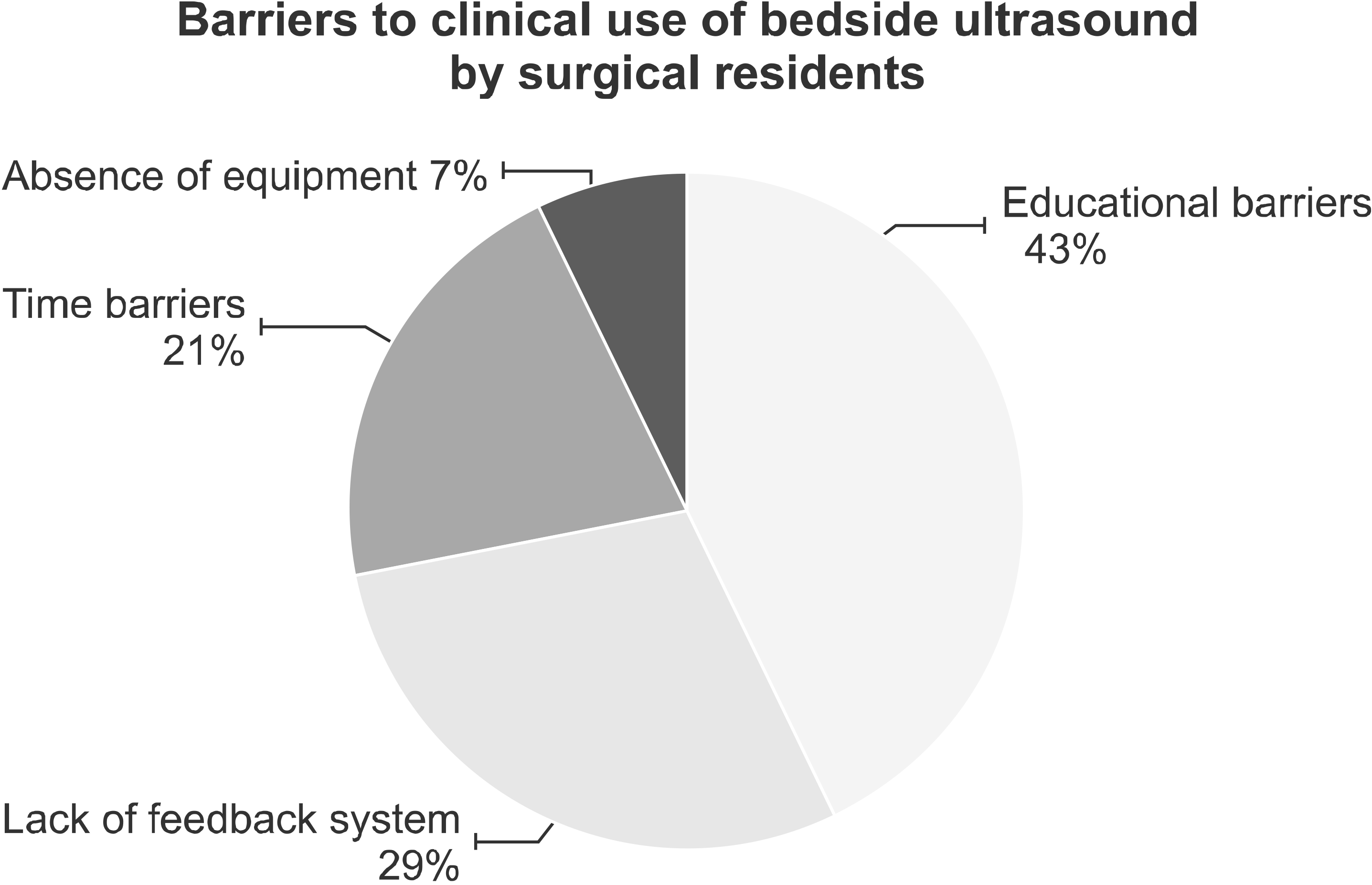3. Kim DY, Lee JH, Jung JY, Kwon HS, Chang IW, Kim DK, et al. 2017; Re-evaluation of pediatric emergency ultrasound education for emergency medicine residents. J Korean Soc Emerg Med. 28:650–8.
4. Beggs AD, Thomas PR. 2013; Point of use ultrasound by general surgeons: review of the literature and suggestions for future practice. Int J Surg. 11:12–7. DOI:
10.1016/j.ijsu.2012.11.014. PMID:
23207511.
5. Ghane MR, Gharib M, Ebrahimi A, Saeedi M, Akbari-Kamrani M, Rezaee M, et al. 2015; Accuracy of early rapid ultrasound in shock (RUSH) examination performed by emergency physician for diagnosis of shock etiology in critically ill patients. J Emerg Trauma Shock. 8:5–10. DOI:
10.4103/0974-2700.145406. PMID:
25709245. PMCID:
PMC4335159.

6. Cevik AA, Noureldin A, El Zubeir M, Abu-Zidan FM. 2018; Assessment of EFAST training for final year medical students in emergency medicine clerkship. Turk J Emerg Med. 18:100–4. DOI:
10.1016/j.tjem.2018.05.004. PMID:
30191188. PMCID:
PMC6107923.

7. Helling TS, Wilson J, Augustosky K. 2007; The utility of focused abdominal ultrasound in blunt abdominal trauma: a reappraisal. Am J Surg. 194:728–32. discussion 732–3. DOI:
10.1016/j.amjsurg.2007.08.012. PMID:
18005762.

8. Nassour I, Spalding MC, Hynan LS, Gardner AK, Williams BH. 2017; The surgeon-performed ultrasound: a curriculum to improve residents’ basic ultrasound knowledge. J Surg Res. 213:51–9.

9. Rempell JS, Saldana F, DiSalvo D, Kumar N, Stone MB, Chan W, et al. 2016; Pilot point-of-care ultrasound curriculum at Harvard Medical School: early experience. West J Emerg Med. 17:734–40. DOI:
10.5811/westjem.2016.8.31387. PMID:
27833681. PMCID:
PMC5102600.

10. Lee JH, Kang B, Kwon H, Kim S, Kim JY, Lee JH, et al. 2014; The experience of emergency pediatric ultrasound education course. Pediatr Emerg Med J. 1:34–41. DOI:
10.22470/pemj.2014.1.1.34.

11. Kim JS, Cho YS, Kim YS, Ha YR, Kang BS, Chung HS, et al. 2010; Development of an emergency abdominal ultrasound course in Korea: 1-year experience. J Korean Soc Emerg Med. 21:382–7.
12. Kim BK, Cha JM, Song DS. 2019; How to revitalize the abdominal ultrasonography education program. Korean J Gastroenterol. 73:66–9. DOI:
10.4166/kjg.2019.73.2.66.

13. Choi BI. 2015. Ultrasound Diagnosis of the Abdomen. 3rd ed. Ilchokak;Seoul:
14. Martin JA, Regehr G, Reznick R, MacRae H, Murnaghan J, Hutchison C, et al. 1997; Objective structured assessment of technical skill (OSATS) for surgical residents. Br J Surg. 84:273–8. DOI:
10.1046/j.1365-2168.1997.02502.x. PMID:
9052454.

15. Crouch AK, Dawson M, Long D, Allred D, Madsen T. 2010; Perceived confidence in the FAST exam before and after an educational intervention in a developing country. Int J Emerg Med. 3:49–52. DOI:
10.1007/s12245-009-0144-5. PMID:
20414382. PMCID:
PMC2850974.

16. Pulijala Y, Ma M, Pears M, Peebles D, Ayoub A. 2018; Effectiveness of immersive virtual reality in surgical training- a randomized control trial. J Oral Maxillofac Surg. 76:1065–72. DOI:
10.1016/j.joms.2017.10.002. PMID:
29104028.
17. Fonseca AL, Reddy V, Yoo PS, Gusberg RJ, Longo WE. 2016; Senior surgical resident confidence in performing flexible endoscopy: what can we do differently? J Surg Educ. 73:311–6. DOI:
10.1016/j.jsurg.2015.09.014. PMID:
26531744.

18. Happel CS, Lease MA, Nishisaki A, Braga MS. 2015; Evaluating simulation education via electronic surveys immediately following live critical events: a pilot study. Hosp Pediatr. 5:96–100. DOI:
10.1542/hpeds.2014-0091. PMID:
25646203.

19. Schroll R, Smith A, Martin MS, Zeoli T, Hoof M, Duchesne J, et al. 2020; Stop the bleed training: rescuer skills, knowledge, and attitudes of hemorrhage control techniques. J Surg Res. 245:636–42. DOI:
10.1016/j.jss.2019.08.011. PMID:
31525629.

20. Carver TW. 2018; Ultrasound training in surgical critical care fellowship: a survey of program directors. J Surg Educ. 75:1250–5. DOI:
10.1016/j.jsurg.2018.01.017. PMID:
29449161.

21. Tolsgaard MG, Todsen T, Sorensen JL, Ringsted C, Lorentzen T, Ottesen B, et al. 2013; International multispecialty consensus on how to evaluate ultrasound competence: a Delphi consensus survey. PLoS One. 8:e57687. DOI:
10.1371/journal.pone.0057687. PMID:
23469051. PMCID:
PMC3585207.

22. Tolsgaard MG. 2018; Assessment and learning of ultrasound skills in Obstetrics & Gynecology. Dan Med J. 65:B5445.
23. Celebi N, Griewatz J, Malek NP, Hoffmann T, Walter C, Muller R, et al. 2019; Outcomes of three different ways to train medical students as ultrasound tutors. BMC Med Educ. 19:125. DOI:
10.1186/s12909-019-1556-4. PMID:
31046757. PMCID:
PMC6498570.

24. Knudsen L, Nawrotzki R, Schmiedl A, Mühlfeld C, Kruschinski C, Ochs M. 2018; Hands-on or no hands-on training in ultrasound imaging: a randomized trial to evaluate learning outcomes and speed of recall of topographic anatomy. Anat Sci Educ. 11:575–91. DOI:
10.1002/ase.1792. PMID:
29683560.

25. LoPresti CM, Schnobrich DJ, Dversdal RK, Schembri F. 2019; A road map for point-of-care ultrasound training in internal medicine residency. Ultrasound J. 11:10. DOI:
10.1186/s13089-019-0124-9. PMID:
31359161. PMCID:
PMC6638610.

26. Williams RJ, Windsor AC, Rosin RD, Mann DV, Crofton M. 1994; Ultrasound scanning of the acute abdomen by surgeons in training. Ann R Coll Surg Engl. 76:228–33. PMID:
8074382. PMCID:
PMC2502236.
27. Trajkovski T, Veillette C, Backstein D, Wadey VM, Kraemer B. 2012; Resident self-assessment of operative experience in primary total knee and total hip arthroplasty: is it accurate? Can J Surg. 55:S153–7. DOI:
10.1503/cjs.035510. PMID:
22854152. PMCID:
PMC3432254.

28. Arora S, Miskovic D, Hull L, Moorthy K, Aggarwal R, Johannsson H, et al. 2011; Self vs expert assessment of technical and non-technical skills in high fidelity simulation. Am J Surg. 202:500–6. DOI:
10.1016/j.amjsurg.2011.01.024. PMID:
21943950.







 PDF
PDF Citation
Citation Print
Print




 XML Download
XML Download